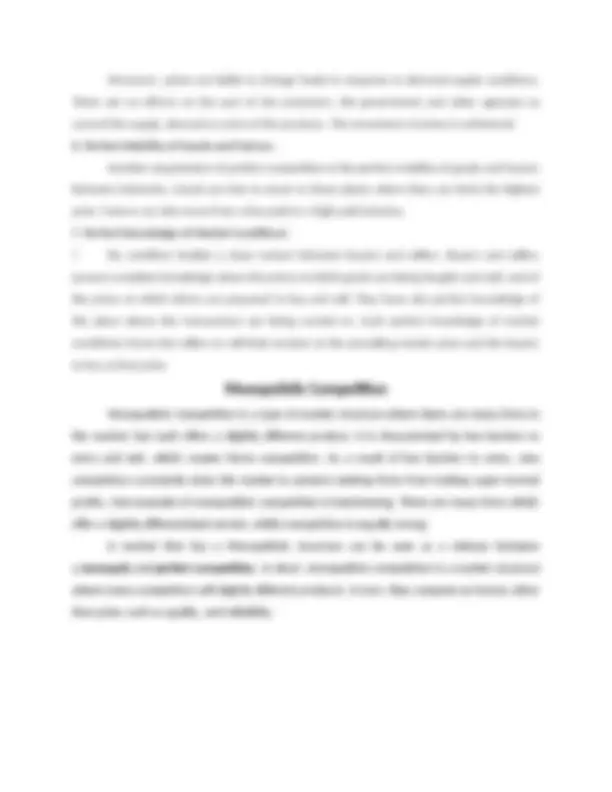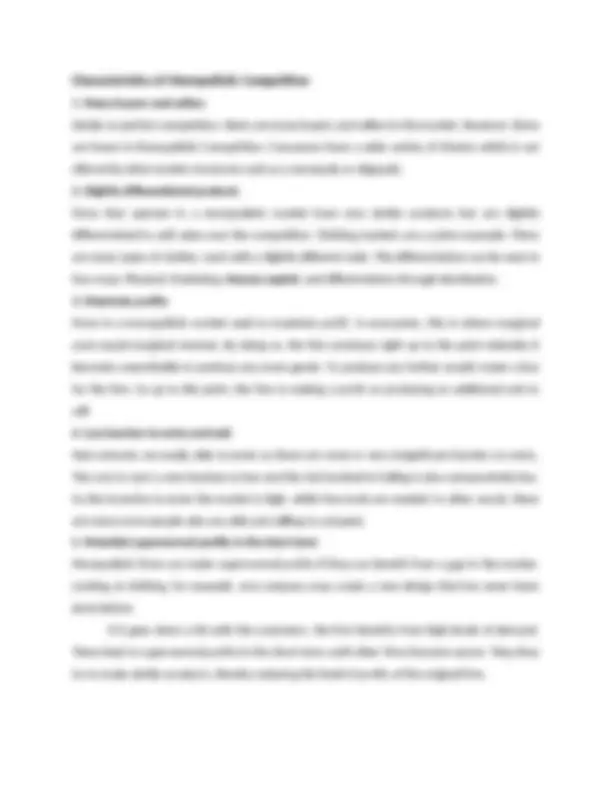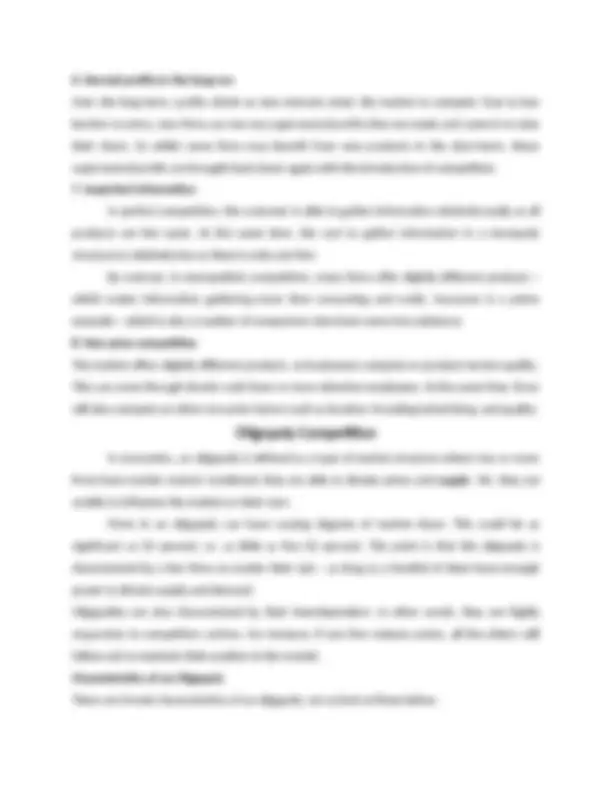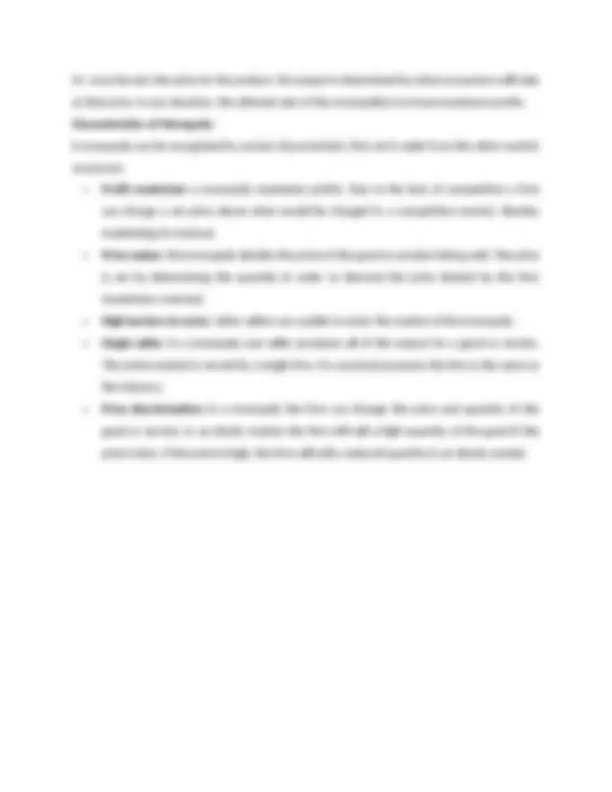






Study with the several resources on Docsity

Earn points by helping other students or get them with a premium plan


Prepare for your exams
Study with the several resources on Docsity

Earn points to download
Earn points by helping other students or get them with a premium plan
Community
Ask the community for help and clear up your study doubts
Discover the best universities in your country according to Docsity users
Free resources
Download our free guides on studying techniques, anxiety management strategies, and thesis advice from Docsity tutors
The concept of market structure in economics and the characteristics of perfect competition, oligopoly, and monopoly markets. It discusses the conditions required for perfect competition, such as a large number of buyers and sellers, freedom of entry or exit of firms, homogeneous products, and absence of artificial restrictions. It also explains the characteristics of oligopoly markets, such as a few firms with large market share, high barriers to entry, interdependence, and higher prices than perfect competition. Finally, it defines monopoly markets as those with only one seller and barriers to entry.
Typology: Schemes and Mind Maps
1 / 8

This page cannot be seen from the preview
Don't miss anything!





Market structure, in economics, refers to how different industries are classified and differentiated based on their degree and nature of competition for goods and services. It is based on the characteristics that influence the behavior and outcomes of companies working in a specific market. Perfect Competition Market: Perfectly competitive market is one in which the number of buyers and sellers is very large, all engaged in buying and selling a homogeneous product without any artificial restrictions and possessing perfect knowledge of market at a time. In the words of A. Koutsoyiannis, “Perfect competition is a market structure characterised by a complete absence of rivalry among the individual firms.” According to R.G. Lipsey, “Perfect competition is a market structure in which all firms in an industry are price- takers and in which there is freedom of entry into, and exit from, industry.” Characteristics of Perfect Competition: The following are the conditions for the existence of perfect competition:
1. Large Number of Buyers and Sellers: The first condition is that the number of buyers and sellers must be so large that none of them individually is in a position to influence the price and output of the industry as a whole. The demand of individual buyer relative to the total demand is so small that he cannot influence the price of the product by his individual action.
Similarly, the supply of an individual seller is so small a fraction of the total output that he cannot influence the price of the product by his action alone. In other words, the individual seller is unable to influence the price of the product by increasing or decreasing its supply. Rather, he adjusts his supply to the price of the product. He is “output adjuster”. Thus no buyer or seller can alter the price by his individual action. He has to accept the price for the product as fixed for the whole industry. He is a “price taker”.
2. Freedom of Entry or Exit of Firms: The next condition is that the firms should be free to enter or leave the industry. It implies that whenever the industry is earning excess profits, attracted by these profits some new firms enter the industry. In case of loss being sustained by the industry, some firms leave it. 3. Homogeneous Product: Each firm produces and sells a homogeneous product so that no buyer has any preference for the product of any individual seller over others. This is only possible if units of the same product produced by different sellers are perfect substitutes. In other words, the cross elasticity of the products of sellers is infinite. No seller has an independent price policy. Commodities like salt, wheat, cotton and coal are homogeneous in nature. He cannot raise the price of his product. If he does so, his customers would leave him and buy the product from other sellers at the ruling lower price. The above two conditions between themselves make the average revenue curve of the individual seller or firm perfectly elastic, horizontal to the X-axis. It means that a firm can sell more or less at the ruling market price but cannot influence the price as the product is homogeneous and the number of sellers very large. 4. Absence of Artificial Restrictions: The next condition is that there is complete openness in buying and selling of goods. Sellers are free to sell their goods to any buyers and the buyers are free to buy from any sellers. In other words, there is no discrimination on the part of buyers or sellers.
1. Many buyers and sellers Similar to perfect competition, there are many buyers and sellers in the market. However, there are fewer in Monopolistic Competition. Consumers have a wide variety of choices which is not offered by other market structures such as a monopoly or oligopoly. 2. Slightly differentiated products Firms that operate in a monopolistic market have very similar products but are slightly differentiated to add value over the competition. Clothing markets are a prime example. There are many types of clothes, each with a slightly different style. This differentiation can be seen in four ways: Physical, Marketing, Human capital , and differentiation through distribution. 3. Maximise profits Firms in a monopolistic market seek to maximize profit. In economics, this is where marginal costs equal marginal revenue. By doing so, the firm produces right up to the point whereby it becomes unprofitable to produce any more goods. To produce any further would create a loss for the firm. So up to this point, the firm is making a profit on producing an additional unit to sell. 4. Low barriers to entry and exit New entrants are easily able to enter as there are none or very insignificant barriers to entry. The cost to start a new business is low and the risk involved in failing is also comparatively low. So the incentive to enter the market is high, whilst few tools are needed. In other words, there are many more people who are able and willing to compete. 5. Potential supernormal profits in the short term Monopolistic firms can make supernormal profits if they can benefit from a gap in the market. Looking at clothing, for example, one company may create a new design that has never been done before. If it goes down a hit with the customers, the firm benefits from high levels of demand. These lead to supernormal profits in the short-term until other firms become aware. They then try to make similar products, thereby reducing the level of profits of the original firm.
6. Normal profits in the long-run Over the long-term, profits shrink as new entrants enter the market to compete. Due to low barriers to entry, new firms can see any supernormal profits that are made and come in to take their share. So whilst some firms may benefit from new products in the short-term, these supernormal profits are brought back down again with the introduction of competition. 7. Imperfect information In perfect competition, the customer is able to gather information relatively easily as all products are the same. At the same time, the cost to gather information in a monopoly structure is relatively low as there is only one firm. By contrast, in monopolistic competition, many firms offer slightly different products – which makes information gathering more time consuming and costly. Insurance is a prime example – which is why a number of comparison sites have come into existence. 8. Non-price competition The market offers slightly different products, so businesses compete on product/service quality. This can come through shorter wait times or more attentive employees. At the same time, firms will also compete on other non-price factors such as location, branding/advertising, and quality.
In economics, an oligopoly is defined as a type of market structure where two or more firms have market control. Combined, they are able to dictate prices and supply. Yet, they are unable to influence the market on their own. Firms in an oligopoly can have varying degrees of market share. This could be as significant as 50 percent, or, as little as five (5) percent. The point is that the oligopoly is characterized by a few firms no matter their size – as long as a handful of them have enough power to dictate supply and demand. Oligopolies are also characterized by their interdependent. In other words, they are highly responsive to competitors actions. For instance, if one firm reduces prices, all the others will follow suit to maintain their position in the market. Characteristics of an Oligopoly There are 6 main characteristics of an oligopoly. Let us look at these below:
5. Higher Prices than Perfect Competition Under perfect competition, prices are just above marginal cost , leaving firms with small profits
Or, once he sets the price for his product, his output is determined by what consumers will take at that price. In any situation, the ultimate aim of the monopolist is to have maximum profits. Characteristics of Monopoly: A monopoly can be recognized by certain characteristics that set it aside from the other market structures: Profit maximizer: a monopoly maximizes profits. Due to the lack of competition a firm can charge a set price above what would be charged in a competitive market, thereby maximizing its revenue. Price maker: the monopoly decides the price of the good or product being sold. The price is set by determining the quantity in order to demand the price desired by the firm (maximizes revenue). High barriers to entry: other sellers are unable to enter the market of the monopoly. Single seller: in a monopoly one seller produces all of the output for a good or service. The entire market is served by a single firm. For practical purposes the firm is the same as the industry. Price discrimination: in a monopoly the firm can change the price and quantity of the good or service. In an elastic market the firm will sell a high quantity of the good if the price is less. If the price is high, the firm will sell a reduced quantity in an elastic market.